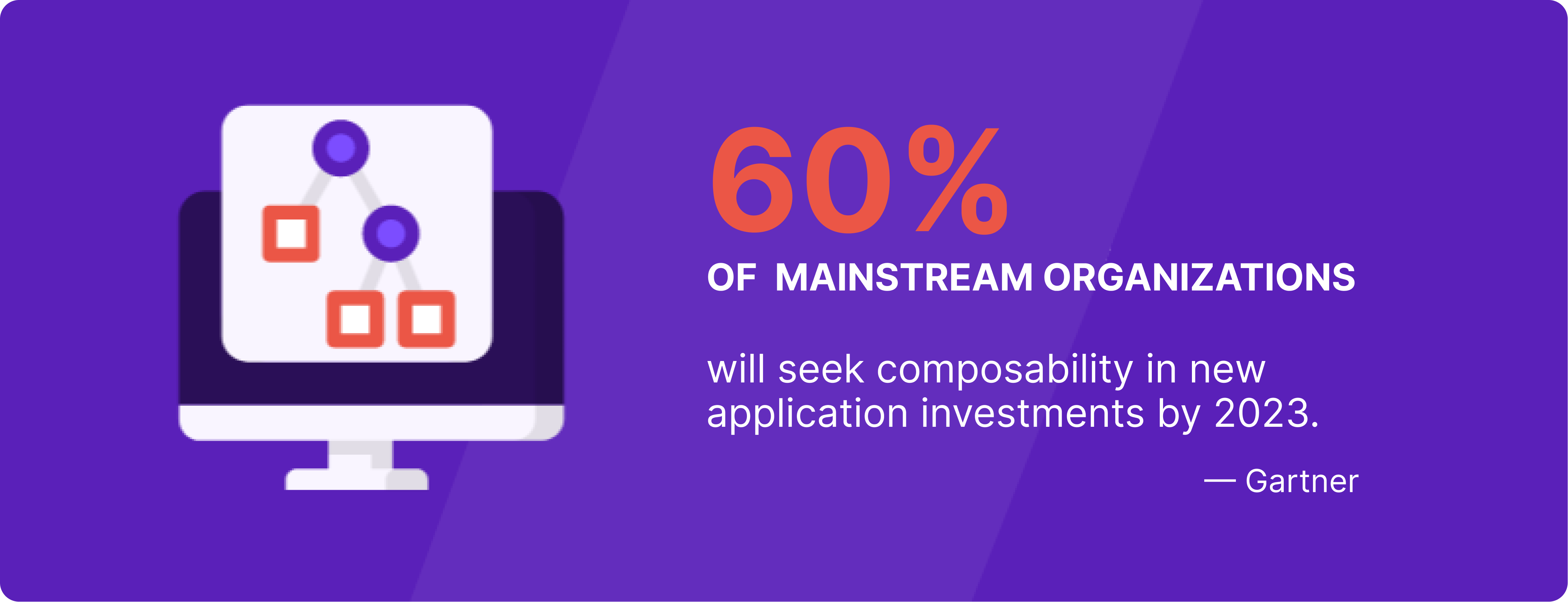Composable architecture vs. microservices: Differences explained

Share

Composable architecture vs. microservices: Discover the key differences to decide the ideal option for your organization. Composable architecture allows you to use interchangeable modules, while microservices focus on independent services.
Highlights
You’ll learn about the differences between composable architecture vs. microservices.
Composable architecture:
- Focuses on flexible, reusable, and interchangeable components
- Integrates various independent systems
Microservices:
- Emphasizes modular, loosely coupled services
- Each service functions independently of other services
Choosing the right approach depends on your business needs. With Contentstack, you can enjoy the benefits of microservices in a composable architecture.
With the pace of new technology adoption, businesses must be flexible to stay competitive. Composable architecture and microservices are making positive waves in business tech. They offer ease of use and support for innovation and business growth.
Gartner has been bullish about composable. They predict that businesses that have adopted it will outpace their competition by 80%. Several studies also show an increase in productivity when brands implement microservices.
What makes these approaches special is that they help organizations build scalable systems. Composable architecture uses reusable parts to create systems, while microservices split apps into small, independent pieces. Both architectural approaches offer various levels of flexibility that allow businesses to adapt to change.
Understanding composable architecture
Composable architecture comprises an array of plug-and-play modules, such as packaged business capability (PBC), microservices, headless CMS, and API-first design. It is a modular approach to software design that allows you to build reusable, flexible, and adaptable apps.
You can develop, deploy, and scale each component independently. That allows you to build agile business solutions. For example, you can combine a CRM system with an inventory management module to streamline sales and stock control.
Key features of a composable architecture
There are major features that make the system effective:
- Modular components: Applications are broken into smaller, independent parts, each with a specific function.
- Reusable parts: These are pre-built system units that you can use in different projects and contexts, saving time and resources and reducing redundancy.
- Standardized interfaces: Components interact via standardized interfaces. Hence, it is easier to integrate and replace them as needed without upsetting the existing system.
Benefits of a composable architecture
- Scalability: The ability to plug in new modules makes it easy for businesses to expand and adapt to market shifts. At any point, you can scale one part of the system based on user demands.
- Flexibility: The modular setup allows you to reconfigure, update or replace individual components, which allows you to adapt to changes.
- Adaptability: In fast-paced industries, a modular architecture allows you to swap out obsolete systems for more relevant ones.

Understanding microservices
Microservices architecture breaks your application into small, independent, loosely coupled services. Each service handles a specific task and interacts via APIs. This type of distributed system is suited to complex applications with many functional components.
Core principles of microservices
This system follows several core principles:
- Independent services: Each service runs separately. You can build, test, and deploy one service without affecting the rest of your system.
- Fault isolation: If one service fails, it does not crash the entire system. For instance, if the payment service goes down, other services like user accounts keep running. This prevents full system downtime.
- Technology diversity: You can choose the tech stack that suits each microservice. That way, you can optimize performance.
- Ease of use: They support a plug-and-play approach that is easy to deploy. So you do not have to rely on extensive coding to set it up.
Benefits of microservices
Microservices offer several key benefits for your business, such as:
- Scalability: You can scale individual services based on demand. For instance, you can allocate extra computing resources to one part of the system to adapt to increased demand.
- Faster updates: By supporting CI/CD practices, you can speed up updates and deployment cycles. That allows you to release new features or bug fixes as needed quickly.
- Cost efficiency: You localize efforts to specific services and only focus on specific functions. That way, there are no redundancies, which allows you to reduce overall costs.
- ROI benefits: A microservice approach saves costs. It also allows you to release new products faster, increasing time to marketing and leading to higher ROI.
Composable architecture vs. microservices: How they relate
Both approaches are similar in that they are flexible and technology-agnostic. They allow you to use different frameworks within the same app. Both support reusable software components, CI/CD practices, and API integration. Using either approach, you can also deploy small, autonomous teams that own specific services.
Composable architecture vs. microservices: Key differences
Both approaches offer flexible and scalable ways to manage apps and projects, but they do so in distinct ways. Ensure you understand these differences when choosing between them. Here is a guide on how they stack up.
Feature | Composable | Microservices |
Scope of independence | System components are interdependent and tightly integrated. | Services are decoupled and independent |
Development approach | Uses reusable building blocks that align with specific projects | Design services based on business capabilities |
Implementation | It can incorporate microservices, modular front-ends, headless CMS, and API-first design | You can use design patterns and containers like Docker, as well as service meshes |
Granularity | Varies, and may include broader modules or entire applications | More granular, each service handles a specific task |
Suitable use cases for different business models
Composable architecture is suitable for businesses that require frequent changes and high customization. For instance, e-commerce brands will enjoy having a system that can be customized according to their users' needs.
However, microservices work best for large and complex apps that require development teams to work on different parts of the system simultaneously. Think of Saas platforms and financial services, where you need constant uptime and a unified user experience.
Strategic considerations for 2025
Business leaders must consider several factors when choosing between composable architecture and microservices, as follows:
- Business goals: Define your long-term goals. If agility and rapid innovation are key, go composable. If stability and fault tolerance are priorities, microservices are more suitable.
- Development speed: Composable architecture lets you build faster. They are pre-built, and you can easily prototype them. Microservices might take longer to build as each service needs to be developed and tested.
- System complexity: Composable architecture suits systems with clear, distinct functions, such as e-commerce platforms, while microservices suit complex systems, like ride-sharing apps that handle ride requests, payments, and user notifications as separate functions.
Case studies
Technical Safety BC
Technical Safety BC handled massive traffic with over 3000 pages on their old website. However, many of those pages were orphaned. The CMS was siloed to one person, and brand alignment suffered.
By reaching out to Contentstack, they were able to address those issues. Contentstack offers a composable DXP with a headless CMS. It is also based on MACH principles—microservices, API-first, cloud-native, and headless. After the switch, website speed increased 150 times, page count reduced by 60%, and traffic grew by 73%.
“The new structure and consistency across the site has enabled our teams to easily find what they need when they are helping clients locate information on our site,” Ian Colvin, Leader of Communications and Digital Experience, said.
Read the case study here.
GetYourGuide
GetYourGuide employs multiple content creators and brand influencers to deliver travel content to their audience. However, the website’s limited bandwidth was a bottleneck. Hence, they were unable to adapt to new travel trends.
By switching to Contentstack’s composable DXP with a headless CMS, they could deliver personalized content to over 500,000 unique website visitors. They also improved deployment speed by 90% and reduced content approval time by 75%.
Hear from Pedro Torres, the product manager. "With Contentstack, we can deliver on -- and exceed -- what customers are expecting, regardless of device, and consistently deliver those experiences as soon as new travel opportunities become available."
Read more about how GetYourGuide leveraged Contentstack to enrich travel experiences.
Strategic insights for scalable business solutions
An API-first approach and modular design are two principles you can associate with composable and microservices architectures. The use of APIs enables seamless data integration and data sharing.
Also, open-source tools like Kubernetes and Docker provide a platform to automate scaling and deployment and ship and run applications in containers. These tools improve ease of use and increase ROI by reducing cost.
Future trends in software architecture
Looking ahead, here are a few trends to watch:
Increased focus on serverless
Serverless computing lets you run code without managing servers. You write your function, and a cloud service runs it when needed. This approach works well with both composable and microservices architectures.
For composable systems, each software component could be a serverless function. In microservices, individual services can run serverless. This setup makes scaling easier and often costs less. You pay only when your code runs, not for idle server time.
Growth in multi-cloud strategies
The multi-cloud approach enables organizations to deploy apps on private, public, and edge clouds based on their needs. This will add a layer of flexibility and allow businesses to leverage multiple cloud services. With this approach, you can easily scale workloads, save costs, and avoid vendor lock-in.
FAQ section
What is the difference between composable and microservices architecture?
Composable architecture is focused on the building blocks that form a complete system when put together. Microservices architecture consists of small discrete services that interact via APIs.
What is composable architecture?
Composable architecture is a modular approach that allows you to build applications from reusable components.
What is the difference between composable architecture and monolithic architecture?
Composable architecture is modular and flexible. It lets you update or replace individual components. Monolithic architecture is a single, unified system. To make changes, you must alter the entire application.
Is REST API a microservice?
No. A REST API is a protocol that enables interaction between services. While it can be used in microservices architectures, it is not exclusive to them.
Learn more
Both composable architecture and microservices offer unique advantages for scalable business solutions. Knowing their key differences will help you choose the best fit to deliver higher ROI and future-proof your tech stack.
You could also choose an alternative that allows you to leverage the benefits of the two approaches. Contentstack’s composable DXP is MACH-enabled. So, you leverage the benefits of microservices, APIs, cloud, and headless CMS. It allows you to use microservices as a building block for your apps within a composable architecture. Talk to us today to see how it works.



